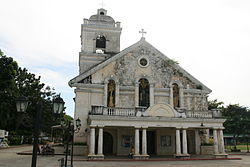Palompon
|
Palompon Hinablayan |
|
|---|---|
| Municipality | |
 |
|
 Map of Leyte with Palompon highlighted |
|
| Location within the Philippines | |
| Coordinates: 11°03′N 124°23′E / 11.050°N 124.383°ECoordinates: 11°03′N 124°23′E / 11.050°N 124.383°E | |
| Country | Philippines |
| Region | Eastern Visayas (Region VIII) |
| Province | Leyte |
| District | 4th district of Leyte |
| Established | 1620 |
| Barangays | 50 |
| Government | |
| • Mayor | Ramon c. Oñate |
| Area | |
| • Total | 126.07 km2 (48.68 sq mi) |
| Population (2015 census) | |
| • Total | 58,108 |
| • Density | 460/km2 (1,200/sq mi) |
| Time zone | PST (UTC+8) |
| ZIP code | 6538 |
| IDD : area code | +63 (0)53 |
| Income class | 2nd municipal income class |
| 083740000 | |
| Electorate | 37,153 voters as of 2016 |
Palompon is a 2nd class municipality in the province of Leyte, Philippines. According to the 2015 census, it has a population of 58,108 people.
Ongoing infrastructure development efforts in Palompon including road construction, installation of electric power, setting up of communications facilities and rehabilitation of the sea port will enhance the position of the town as a trading center for north-western Leyte, its traditional role during the pre and post war era. The terrain of Palompon, which is generally sloping, limits the agricultural potential of the municipality. The dominant soil type (Faraon clay) is suited mainly for marginal upland crops, such as bananas, coconuts, and sweet potatoes.The destruction of the forest and critical watershed an area contribute to ongoing soil erosion and poses a major threat to the water supply of the town and its barangays.
Palompon has a very young population with 43.5% total population are less than 20 years old. The population is equally balanced between females (50.3%) and males (49.7%).
Palompon is composed of 50 barangays, 10 of which is located in the poblacion while the remaining 40 are located along the coastal and interior parts of the municipality. Some 26% of the population resides in the poblacion barangays while the remaining 74% are found in rural areas. Palompon is densely populated, with 3.92 persons per hectare. This is much higher than the population density of Region VIII, which is 1.56 persons per hectare. However, population density is not evenly distributed among the barangays. The poblacion barangays are the most densely populated (Central – II is ranked first at 682 persons per hectare) while the hinterland barangays are the most sparsely-populated (Hinagbuan ranked last with 1.22 persons per hectare). Palompon had a literacy rate of 91.30% as per 1990 census. The municipality has as extensive educational system consisting of 45 elementary schools, 7 high schools and one state college (Palompon Institute of Technology), which is a well-known and respected institution in the province.The population growth rate has been relatively slow, averaging less than 1.4% annually during the period 1980-91, although this increased to 2.12% from 1991-95. The average percentage of deaths over births is 26.15 per 1,000, which is approximately one death rate and relatively slow increase in population, there appears to be a net out-migration of residents from Palompon. This is consistent with the overall trend of out-migration in Region VIII.One form of out-migration occurs when Palomponganons leave their hometown for Cebu, Manila or abroad where they can find well-paying jobs. The lack of well-paying job opportunities in Palompon encourage many skilled people (e.g. seamen, carpenters, contractors, etc.) to leave the town. The education programs offered by the PIT, which focus on marine transportation and engineering, are also in favor of this trend. A second (and more serious) form of out-migration occurs within Palompon itself where residents from the hinterland barangays migrate to the poblacion barangays. Many of these migrants join the rank of subsistence fisher folk while others become tricycle (or “trisikad”) drivers. The in-migration of these upland dwellers has given rise to slum communities, particularly in the poblacion barangays of Ipil—I, Ipil-II and Lili-on.
...
Wikipedia

